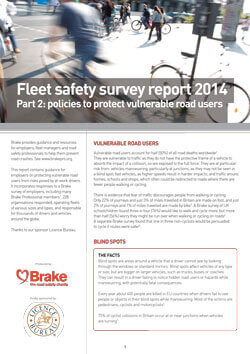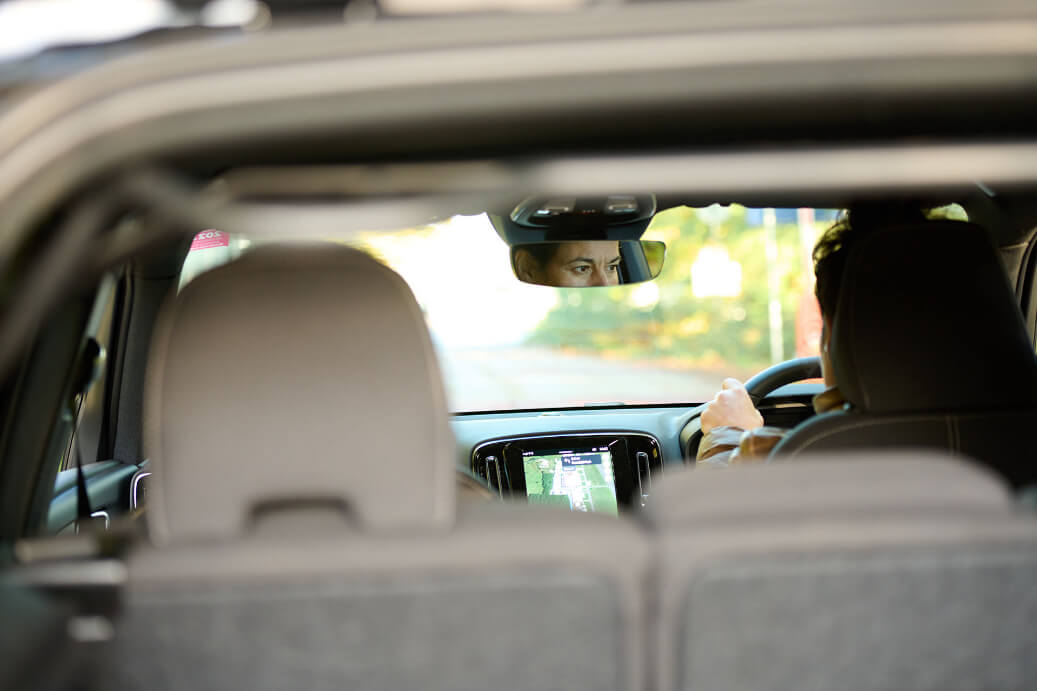Brake, the road safety charity, is issuing an appeal to employers to play their part in preventing devastating casualties among pedestrians and cyclists. Newly-released government figures show 6 people are killed and 157 seriously injured every week while walking or cycling. At least 24% of road deaths and serious injuries involve a vehicle being driven for work [1].
A Brake and Licence Bureau report out today (15 Oct) finds that among companies with staff who drive for work, many don’t have good practice procedures to protect people on foot and bike:
- More than half (54%) don’t provide driver education on protecting pedestrians and cyclists;
- Two-thirds (68%) don’t instruct drivers to slow down to 20mph around schools, homes and shops;
- Six in 10 (61%) don’t instruct drivers on looking twice and checking mirrors at junctions for cyclists or motorcyclists;
- Nine in 10 (89%) don’t plan routes to avoid schools and residential areas;
- Eight in 10 (80%) don’t use blind spot sensors and seven in 10 (70%) don’t use blind spot cameras on large commercial vehicles;
- Almost half (45%) don’t use telematics to monitor driver speed, so have no way of knowing if drivers are routinely endangering others by driving too fast.
The survey included 228 companies operating commercial vehicles, company cars or vans, or with employees who drive their own vehicles to business appointments.
Read the attached copy of the report, including full results, background statistics, and advice for employers.
Brake advises employers with staff who drive for work to take a range of steps to protect our most vulnerable road users – pedestrians, cyclists and motorcyclists, who account for 59% of UK road deaths and serious injuries [2]. These steps include thorough journey planning, driver education, making use of technology to minimise blindspots and monitor speed, and building a culture of always putting safety first.
Les Owen from Licence Bureau says: “The Brake and Licence Bureau report highlights something many drivers do not realise: that a few key actions will reduce risks to vulnerable road users but add very little time to journeys, especially in urban areas. Very little work is involved for companies to show an interest in improving road safety and yet so few do anything about it. Companies hold the keys but do not engage in the process. Is it fear of challenging staff about driving?
“Delivering work related road risk messages is key to preventing incidents on the road. Licence Bureau regularly delivers interactive presentations to professional drivers and managers: these are very well received, especially by managers who go away knowing what they can do to involve their staff in reducing risks without challenging them. There is every reason for companies to make road safety a priority, and incidentally save money over time. Ask yourself: why shouldn’t I do more to unlock the road safety improvement toolbox?
“As Brake states it is a simple process of putting safety first and providing key messages. Start with engaging staff who drive at work but also those who are vulnerable road users. They could all be given safety messages to reduce staff absences through injury or worse. Drive safely.”
Ellie Pearson, senior professional engagement officer at Brake, says: “Employers have a crucial role to play in preventing people on foot and bicycle needlessly losing their lives or suffering terrible injuries. Some are working hard and taking advantage of new technologies to minimise the risks their staff pose when driving on company time. And we know that when employers reduce these risks, they reap benefits like reduced costs and enhanced morale and reputation. But it is disappointing that many employers are failing to take simple steps to ensure their drivers are doing everything possible to protect pedestrians and cyclists. We’re appealing to all employers with staff who drive for work to get the right policies in place, make use of technologies to address blindspots and speeding, and ensure their drivers understand that protecting people always comes first.”
More facts
It is estimated that up to 95% of crashes are down to driver error [3]. It is therefore vital that drivers understand the importance of safety, and the simple steps they are expected to take to protect themselves and others.
Speed is a critical factor in all road crashes and casualties, determining whether a driver can stop in time in an emergency, and if they can’t stop, how hard they will hit [4]. It’s a particularly important factor in protecting vulnerable road users. It has been estimated that a 1km/h reduction in average speed across Europe would save 2,200 lives each year [5].
Blind spots, the areas around a vehicle that a driver cannot see by looking through the windows or standard mirrors, are a particular risk to vulnerable road users. Every year about 400 people, mostly vulnerable road users, are killed in EU countries when drivers fail to see people or objects in their blind spots while manoeuvring [6]. Blind spots are a particular risk on larger vehicles, such as trucks, which are involved in almost a quarter (23%) of cyclist deaths in Britain, despite making up only 5% of road traffic [7].
The simplest way to reduce the risk vehicles pose to people is to reduce the number of vehicles. The UK has one of the lowest levels of cycling in Europe [8], and fear of traffic is frequently cited as a barrier to cycling among people who would like to start cycling or cycle more [9]. Reducing vehicle traffic not only makes roads safer, it also benefits the environment, as 21% of UK greenhouse gas emissions come from transport [10]. Encouraging and enabling active forms of travel such as walking or cycling also significantly improves people’s health and benefits the economy: poor health due to inactivity is estimated to cost £8.2 billion per year in England [11].
Case study
Eilidh Cairns, 30, from Ellingham in Northumberland, was killed in London on 5 February, 2009, when she was run over by an HGV.
Eilidh, an experienced cyclist, was cycling to work along the same route she had used for three years. Just before 9am, she was hit from behind by a fully laden 32 tonne tipper truck. She was dragged under the wheels, her pelvis crushed, and left pinned to the road, quietly begging passers-by for help. She was taken to the Royal London Hospital but by 11am she was dead.
The driver, Mr Joao Lopes, claimed not to have seen Eilidh. His eyesight was found not to meet minimum legal standards; he was found guilty of driving with uncorrected defective vision, receiving three points on his licence and a £200 fine but was allowed to continue driving. Three years later, he was jailed for killing an elderly pedestrian, Nora Gutmann.
Kate Cairns, Eildh’s sister, said: “Eilidh was a strong, fit and experienced cyclist, and aware of the dangers of HGVs. She loved cycling through London and travelled by bike wherever she went. She had even taken her bike when she worked abroad, and negotiated without incident the notorious streets of Dubai and Valencia, such was her competence and love of the freedom her bike afforded. She should not have had to pay for that love with her life.
“Following the death of my sister I was shocked with the realisation that similar deaths were happening on such a regular basis with the majority of drivers simply saying they didn’t see the victim, and this being accepted by the justice system. So I founded the See Me Save Me campaign which calls for the elimination of lorry blind spots. Combating blind spots however requires a lot more than just fitting extra mirrors.
“So we appeal to all companies to fulfil their duty of care to the public and make sure their drivers are fit to be behind the wheel, properly trained to look out for vulnerable people on foot and bike, and that their vehicles are fitted with the latest blind spot technology, to make sure that people like my sister are not carelessly and unnecessarily mown down on our streets.”
Brake’s advice for employers
Employers should ensure drivers understand their responsibility to protect vulnerable road users, and provide clear and specific instructions on simple steps they can take. This should include: slowing right down for bends and brows; slowing down to 20mph or below in built up areas; looking twice and longer for bikes at junctions; and turning off phones.
All fleet managers, especially those with large commercial vehicles, should use the latest available technology to minimise blind spots. This might include: wide-angle mirrors; front, rear and side sensors; reversing alarms; and blind-spot cameras.
Employers should monitor driver speed to ensure drivers are not putting themselves or others at risk. In-vehicle telematics can be used to monitor speed continuously as well as warning drivers if they commit high-risk manoeuvres.
Journeys and routes should be planned to avoid town centres, residential areas and schools, as there are likely to be lots of vulnerable road users in these areas. Schedules should be planned to allow realistic times to complete journeys and allow for possible delays, so drivers are not tempted to speed or take risks.
About the report
The survey results come from Brake and Licence Bureau’s Fleet Safety Survey Report Part Two: vulnerable road users, released today (Wednesday 15 October 2014). 228 organisations that employ drivers responded to the survey, which was conducted online through SurveyMonkey.
[1] Reported road casualties Great Britain 2013, Department for Transport, 2014
[2] Ibid.
[3] Dimensions of aberrant driver behaviour, Uppsala University, Sweden, 1998
[4] Understanding inappropriate high speed: a qualitative analysis, Department for Transport, 2008
[5] Tackling the three main killers on the road, European Transport Safety Council, 2010
[6] Fitting Blind-Spot Mirrors on Existing Trucks: A Consultation Paper, European Commission, 2006
[7] Reported Road Casualties Great Britain: 2013 Annual Report, Focus on pedal cyclists, Department for Transport, 2014
[8] Future of Transport: analytical report, European Commission, 2011
[9] Brake and Direct Line Report on Safe Driving: A Risky Business, Brake, 2011
[10] UK Greenhouse Gas Emissions 2012, Department of Energy and Climate Change, 2014
[11] At least five a week – evidence on the impact of physical activity and its relationship to health: a report from the Chief Medical Officer, Department of Health, 2004

